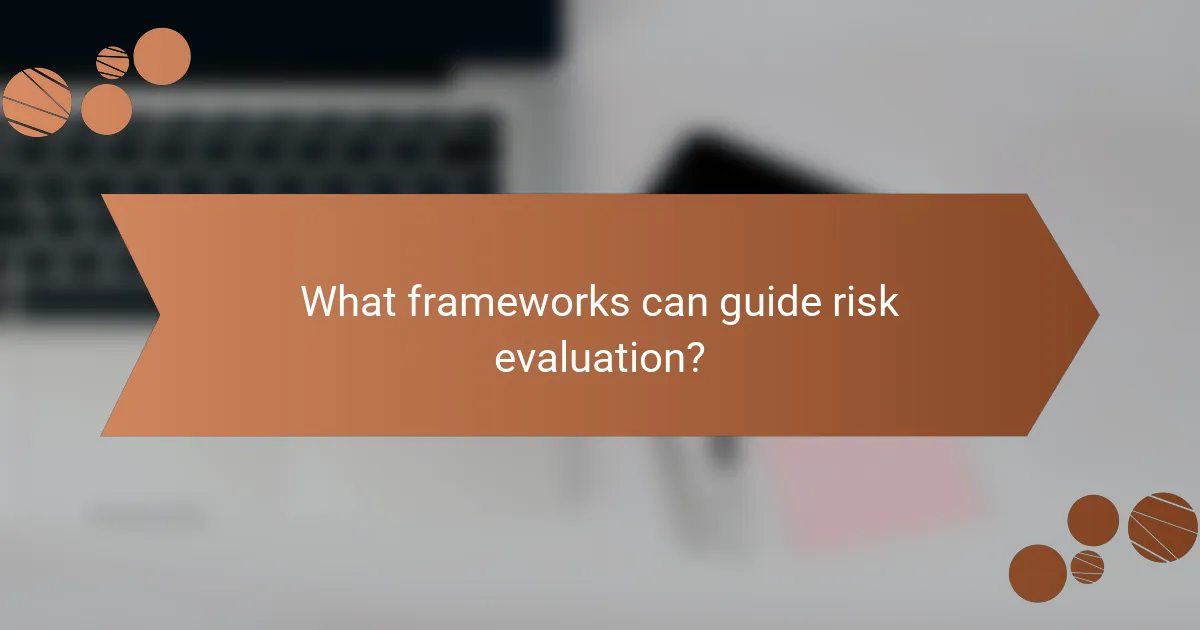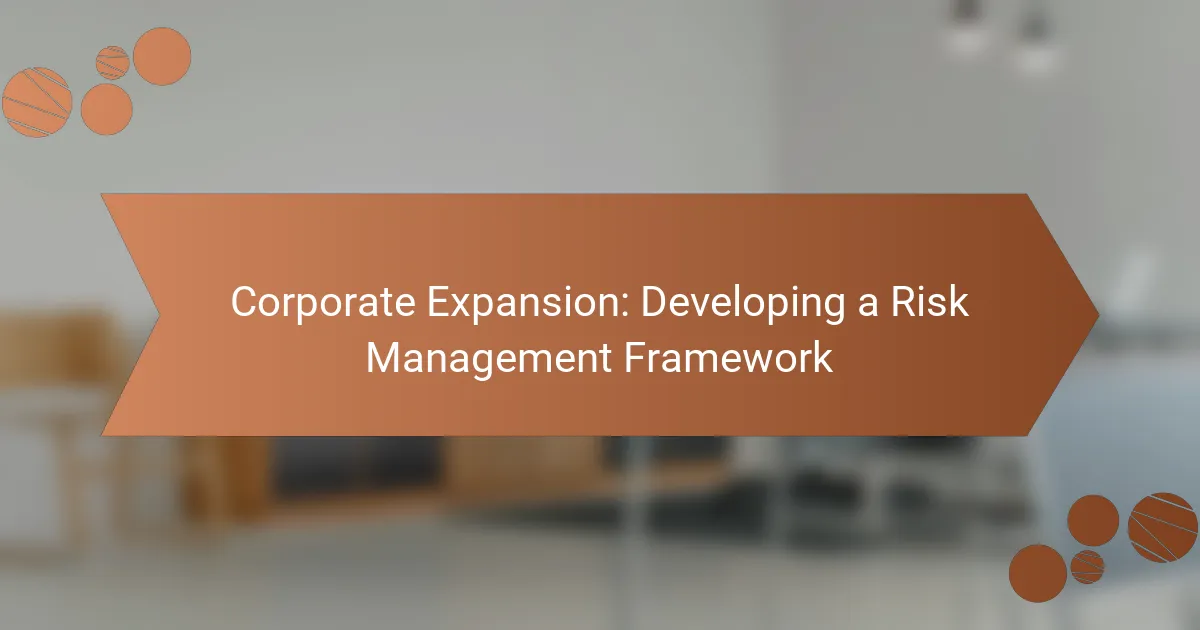In the realm of corporate expansion, evaluating political risks and conducting thorough market analysis are essential steps for success. Key political risks such as regulatory changes and political instability can significantly impact a company’s ability to thrive in new markets. Additionally, a comprehensive market analysis that considers factors like competition and consumer behavior enables businesses to make informed strategic decisions. By employing effective frameworks, companies can systematically navigate these challenges and seize growth opportunities.

What are the key political risks in corporate expansion?
Key political risks in corporate expansion include regulatory changes, political instability, corruption levels, trade policies, and taxation risks. Understanding these factors is crucial for businesses to navigate potential challenges and make informed decisions when entering new markets.
Regulatory changes
Regulatory changes can significantly impact corporate operations and profitability. Companies must stay informed about local laws and regulations that can shift unexpectedly, affecting everything from labor practices to environmental standards.
For example, a sudden increase in compliance requirements may necessitate additional investments in legal and operational adjustments. Businesses should establish a robust monitoring system to track regulatory developments in their target markets.
Political instability
Political instability poses a substantial risk to corporate expansion, as it can lead to unpredictable changes in governance and policy. Events such as protests, coups, or changes in leadership can disrupt business operations and affect market confidence.
Companies should assess the political climate and consider diversifying their investments across more stable regions to mitigate risks associated with instability. Engaging local experts can provide valuable insights into the political landscape.
Corruption levels
High levels of corruption can complicate corporate expansion by increasing costs and risks associated with doing business. Companies may face challenges such as bribery demands or unfair competition, which can undermine ethical standards.
To navigate this risk, businesses should conduct thorough due diligence on potential partners and local practices. Establishing a strong compliance program can help mitigate exposure to corrupt practices.
Trade policies
Trade policies directly influence market access and operational costs for companies looking to expand internationally. Tariffs, quotas, and trade agreements can either facilitate or hinder business activities across borders.
Organizations should analyze existing trade agreements and potential changes in tariffs that could affect their supply chains. Staying informed about trade negotiations can help businesses anticipate shifts that may impact their market strategies.
Taxation risks
Taxation risks can arise from changes in tax laws or rates that affect profitability and cash flow. Companies must understand the local tax environment and any incentives or penalties that may apply to their operations.
Engaging with local tax advisors can provide insights into potential tax liabilities and benefits. Businesses should also consider the implications of double taxation treaties when operating in multiple jurisdictions to optimize their tax strategies.

How to conduct market analysis for expansion?
Conducting market analysis for expansion involves assessing various factors that influence potential growth in a new market. This includes understanding market size, competition, consumer behavior, and internal strengths and weaknesses.
Market size evaluation
Market size evaluation helps determine the potential revenue and customer base in a target area. Start by identifying the total addressable market (TAM) and segmenting it into serviceable available market (SAM) and serviceable obtainable market (SOM).
Utilize industry reports, government data, and market research firms to gather insights. For instance, if expanding into Eastern Europe, consider local economic indicators and consumer spending patterns in currencies like BGN or EUR.
Competitive landscape assessment
Assessing the competitive landscape involves identifying existing players and their market share. Analyze competitors’ strengths, weaknesses, pricing strategies, and customer reviews to understand their positioning.
Tools like SWOT analysis or Porter’s Five Forces can provide a structured approach. For example, in a saturated market, differentiation through unique offerings or superior customer service might be essential for success.
Consumer behavior analysis
Understanding consumer behavior is crucial for tailoring products and marketing strategies. Conduct surveys, focus groups, or analyze social media trends to gain insights into preferences and purchasing habits.
Consider cultural factors that may influence buying decisions. For example, in some regions, sustainability may be a significant factor, while in others, price sensitivity could dominate consumer choices.
SWOT analysis
SWOT analysis evaluates internal strengths and weaknesses alongside external opportunities and threats. This framework helps identify strategic advantages and potential challenges in the new market.
For instance, a company may have strong brand recognition (strength) but face regulatory hurdles (threat). Regularly updating the SWOT analysis can inform strategic adjustments as market conditions evolve.

What frameworks can guide risk evaluation?
Several frameworks can effectively guide the evaluation of political risks and market conditions during corporate expansion. Utilizing these frameworks helps businesses systematically assess external factors that may impact their operations and strategic decisions.
PESTLE analysis
PESTLE analysis is a strategic tool that examines six key external factors: Political, Economic, Social, Technological, Legal, and Environmental. Each factor provides insights into the broader landscape that could affect a company’s performance in a new market.
When conducting a PESTLE analysis, consider the political stability of the target country, economic conditions such as currency fluctuations, social trends that may influence consumer behavior, and legal regulations that could impact operations. For example, a country with a stable political environment and a growing economy may present a more favorable opportunity than one with high political risk and economic instability.
Porter’s Five Forces
Porter’s Five Forces framework helps assess the competitive dynamics within an industry by analyzing five key forces: the threat of new entrants, bargaining power of suppliers, bargaining power of buyers, threat of substitute products, and industry rivalry. Understanding these forces can inform strategic positioning and risk management.
For instance, if the threat of new entrants is high in a market, a company may need to invest more in brand loyalty and customer retention strategies. Conversely, if supplier power is low, businesses might negotiate better terms, reducing operational risks. Evaluating these forces allows companies to identify potential challenges and opportunities in their expansion efforts.

How to mitigate political risks during expansion?
To mitigate political risks during expansion, companies should adopt a proactive approach that includes thorough market analysis, strategic partnerships, and risk management tools. Understanding the political landscape and engaging with local stakeholders can significantly reduce potential threats to business operations.
Establishing local partnerships
Building local partnerships is crucial for navigating political risks. Collaborating with established businesses or local entities can provide valuable insights into the political environment and help in gaining community support. These partnerships can also facilitate smoother entry into the market and enhance credibility.
When seeking local partners, consider their reputation, influence, and alignment with your business values. Conducting due diligence is essential to ensure that the partnership will be beneficial and not expose your company to additional risks.
Diversifying market presence
Diversifying market presence across multiple regions can help mitigate political risks by spreading exposure. If one market faces instability, other markets can provide a buffer, allowing the business to maintain overall stability. This strategy is particularly effective in regions with varying political climates.
Consider entering markets with different political systems or economic conditions. For instance, a company might operate in both stable and emerging markets to balance risks. This approach can also enhance opportunities for growth and innovation.
Political risk insurance
Political risk insurance (PRI) is a financial tool that protects businesses against losses due to political events such as expropriation, political violence, or currency inconvertibility. By securing PRI, companies can safeguard their investments and ensure financial stability in volatile regions.
When considering PRI, evaluate the coverage options available and the specific risks associated with the target market. Policies can vary widely, so it’s important to compare terms and conditions to find the best fit for your business needs. Engaging with reputable insurers who specialize in political risk can provide additional guidance and support.

What are the best practices for market entry strategies?
Effective market entry strategies are crucial for minimizing risks and maximizing opportunities in new markets. Best practices include thorough market research, understanding local regulations, and choosing the right entry mode based on resources and objectives.
Joint ventures
Joint ventures involve partnering with a local business to share resources and expertise. This strategy can provide valuable insights into the local market and help navigate regulatory landscapes. However, it requires clear agreements on profit sharing and decision-making to avoid conflicts.
When considering a joint venture, assess potential partners carefully. Look for companies with complementary strengths and a good reputation in the market. Establishing a joint venture can be a cost-effective way to enter a new market, especially in regions with strict foreign ownership laws.
Franchising
Franchising allows a business to expand by licensing its brand and operational model to local entrepreneurs. This strategy reduces capital investment and operational risks, as franchisees typically handle local management. However, maintaining brand consistency and quality control can be challenging.
Successful franchising requires a well-defined franchise agreement and comprehensive training programs. Consider markets where the franchise model is well understood and culturally accepted, as this can significantly enhance the chances of success.
Direct investment
Direct investment involves establishing a new business operation or acquiring an existing one in the target market. This approach offers full control over operations and the potential for higher returns, but it also comes with significant financial risks and longer timeframes for profitability.
Before pursuing direct investment, conduct a detailed market analysis to understand local demand, competition, and regulatory requirements. Ensure you have sufficient capital and a clear strategy for managing operations in the new market to mitigate risks effectively.



